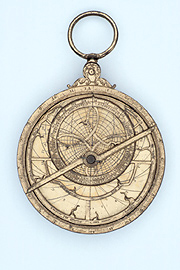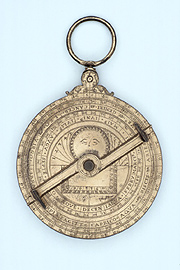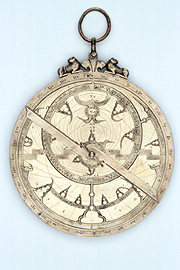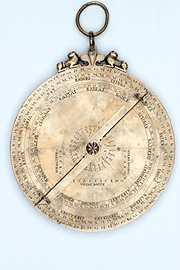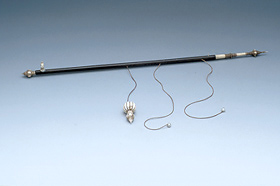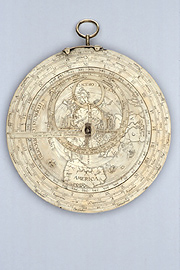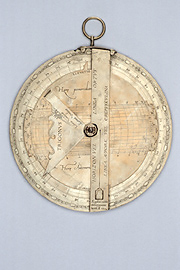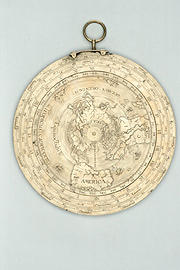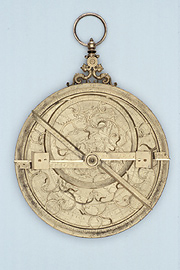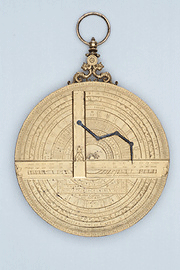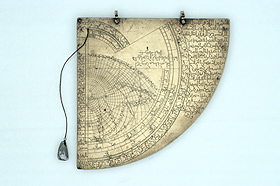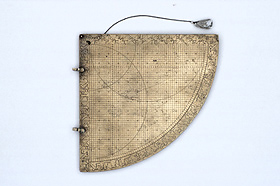|









| |
USING THE ASTROLABE
The
astrolabe was used to make a number of different astronomical calculations.
Users could find things such as the altitude of a star or the sun, the
position of the sun along its annual path through the zodiacal constellations
(the ecliptic) as viewed from earth, the time of sunrise and and sunset
and the length of day. Here are a few instructions for some of these calculations:
Finding
the altitude of a star or sun:
Suspend the
astrolabe by its ring and rotate the alidade until you see the Sun's
shadow or the star through its sight. Note its altitude on the altitude
scale.
Finding the position of the sun along the ecliptic
(the sun's annual path through the zodiacal constellations as seen from earth):
Use the two circles on the back of the astrolabe which give the position of the sun for every date.
Finding the time of sunrise:
Determine the sun's position in the ecliptic. Rotate the rete until that point of the
ecliptic is on the eastern horizon of the latitude plate. Read the time where the rule meets the limb.
Astrolabe
c. 1600
Maker Unknown
England?
Brass
Presented by A.E. Gunther
This astrolabe was first donated to the University in 1659 by
Nicholas Greaves, the brother of John Greaves the Savilian Professor
of Astronomy at Oxford. The rete is similar to that of an astrolabe
signed by the well-known British instrument maker Humfrey Cole,
now at the British Museum. |
Astrolabe,
Hispano-Moorish
c. 1300
Maker Unkown
Spain?
Brass
Billmeir Collection
Islamic designs for the astrolabe, like the bird shaped star pointers
on this rete, were introduced into Europe through Moorish Spain.
The pin, rule and alidade may be later replacements. |
Linear
Astrolabe
1943
Made by Henri Michel
Brussels
Ebony and Ivory
Billmeir Collection
Modern reconstruction of a linear astrolabe described by the 13th
century Iranian mathematician al-Tusi. The baton represents a
specific latitude, while the threads and scales can be used to
represent the circles on a standard astrolabe. |
Geographical
Astrolabe
1560
Made by Gillis Coignet
Antwerp
Brass
Lewis Evans Collection
This astrolabe’s only plate is engraved with a map from the
Tropic of Capricorn to the north Pole, encompassed by a circle
of latitudes. The back includes an unusual Rojas-style sundial. |
Universal
& Geographical Astrolabe
c. 1600
Made by Morillard
Narbonne and Paris, France
Brass & Blued Steel
Billmeir Collection
The Parisian maker Sevin added a Rojas-style universal projection
and a set of rules to this astrolabe in the late 17th century. |
Astrolabe
Quadrant
1804
Made by 'Abdallah Ahmad, born 'Alî al-Andalusî
Moorish?
Brass and Stone
Purchased by the Museum
This astrolabe-quadrant is in the style of the 13th century polymath
Prophatius Judaeus. It was made for a “jurist and noble scribe”
and features lines for the Muslim prayer times. The back features
a sine and cosine graph. It is inscribed ‘for the region
of Meknes’ [in present day Morocco] and is for the latitude
of 34°. |
|

